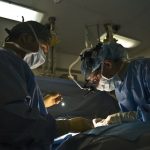What You Need to Know About Cervical Disc Replacements
In the past, the standard treatment for many cervical (neck) problems such as disc herniations, pinched nerves, and spinal stenosis was cervical fusion surgery. A fusion involves causing two bones to grow together(fuse), which removes the normal motion between the bones. Disc replacement surgery is a newer treatment option that replaces a herniated or degenerated disc with an artificial disc. By doing so, motion is preserved which minimizes neck stiffness, allows for a quicker recovery, and provides better long-term function.
Discs are the cushions between the bones (vertebrae) of the spine. The spine is divided into three main regions. The neck is called the cervical spine, the chest is the thoracic spine, and the lower back is the lumbar spine. The cervical spine runs from the base of the skull down to the shoulders and contains seven vertebrae numbered C1 to C7 (The C stands for cervical).
The discs are shaped like jelly donuts with a strong outer ring and a softer center. Following an injury, discs can deteriorate or bulge (herniate) out of place. When a disc moves out of place, it will frequently put pressure on a nerve (called a pinched nerve) and cause pain in the neck or pain radiating down the arms. In more severe situations, the disc can bulge and put pressure on the main spinal cord which controls our entire body.
Symptoms of a Cervical Disc Disorder
Some of the symptoms of a herniated disc or a degenerated disc can include:
- Pain in the neck that is exacerbated with the movement of the neck
- Pain or numbness radiating from the neck into the arms.
- Weakness of the shoulders, arms, hands, and even legs
- Headaches associated with neck pain
- Difficulties with walking or loss of fine motor control of your hands
Treatment of Cervical Disc Disorders
Most cervical disc problems can be treated without surgery. Your physician will take a careful history and do a physical exam to best determine the appropriate treatment and to assess for any nerve injury. Physical therapy and anti-inflammatory medications will allow most patients to recover. If patients do not improve, x-rays and an MRI can provide more details about the cause of the problem. In some situations, stronger medication or spinal injections can provide some relief
When patients fail to improve with non-surgical care, surgery can become an option. In the past, anterior cervical discectomy and fusion (ACDF) was the most common cervical surgery. In an ACDF, the offending disc is removed and the gap between the bones is then filled with a bone graft or plastic cage. A titanium plate with screws is then placed over the front of the vertebra. This procedure removes the normal motion between the bones. Disc replacement preserves motion and has become a well-proven alternative to cervical fusion surgery.
What is a Cervical Disc Replacement?
A disc replacement surgery starts with removing the bad disc and getting pressure off the nerves. Once the nerves are free, the space between the bones is then filled with a disc replacement device. Disc replacement is also known as arthroplasty surgery. The devices typically consist of metallic endplates sandwiching a medical-grade plastic core. Some disc replacements are made of an alloy of Cobalt and Chrome and others are made of a titanium coated plastic known as PEEK. The disc replacement sits between the vertebrae and restores normal motion to the segment.
Who is a Candidate for Cervical Disc Replacement?
Candidates for cervical disc replacement include:
- Patients with cervical disc herniations that have failed to improve with non-operative care (physical therapy, pain medications, and possibly injections).
- Patients with significant neurologic problems (numbness or weakness) from a disc herniation may require earlier surgery instead of the above non-operative treatments.
- Patients over age 65 who have more advanced disc collapse or arthritis may not be candidates for disc replacement.
- Patients with osteoporosis may not be disc replacement candidates.
To find out if a cervical disc replacement is an appropriate route for you, and to get a comprehensive consultation, contact the board-certified doctors at New Jersey Spine Specialists today. Surgical disc replacement surgery must be done meticulously and requires advanced training. We have found that some surgeons default to recommending cervical fusion without fully considering the option of disc replacement.
Advantages of Disc Replacement over Cervical Fusion
Your doctor will determine if you are a candidate for a disc replacement surgery because disc replacement offers several advantages of cervical fusion surgery:
- Disc replacement does not remove motion while a fusion takes away normal motion
- Disc replacement does not have a risk of not healing (called a non-union) while fusions do not always heal. The rate of cervical fusion not healing is increased when more levels are done, in smokers, and in patients with diabetes.
- Disc replacement does not require the use of a cadaver bone graft.
- Disc replacement does not require a plate and screws which sit on top of the vertebra and can cause swallowing difficulty.
- By preserving motion, disc replacement does not put increased stress on the remaining cervical discs. By removing motion and transferring stress to the other levels, fusion surgery accelerates the deterioration of the remaining cervical discs.
How Successful is a Cervical Disc Replacement?
Disc replacement surgery was first FDA approved in 2007 and has undergone vigorous study with multiple randomized controlled trials evaluating its effectiveness. While any surgery carries risk, disc replacement surgery has an excellent track record with high success rates. Pooled analysis of these large studies has found that disc replacement provides durable pain relief with initial results slightly superior to fusion. Longer-term studies are now showing that disc replacement surgery results in better long-term results than fusion with less degeneration and less need for surgery at the adjacent disc levels.
How Long Does It Take to Recover from Cervical Disc Replacement Surgery?
Most disc replacement patients can go home the same day as surgery. Since the procedure does not damage the sensitive muscles and ligaments in the back of the neck, the recovery is relatively rapid. For the first few weeks, patients must wear a neck brace (cervical collar) which can be removed for showering. Because the esophagus is retracted out of the way during surgery, patients can expect a sore throat and minor swallowing difficulty for the first few days. Patients begin to gradually return to light activities within the first few weeks following their surgery, but it takes closer to six weeks to recover more fully. Patients can begin to exercise 6 weeks after the procedure and sports can typically be resumed 3 months following surgery.
How Long Do Artificial Discs Last?
This is a question that surgeons have been thinking about a great deal. Unlike hip and knee replacements, studies have not found artificial discs do not wear out over time. This may be since the head is much lighter than our whole body or to the disc environment which does not have joint fluid. We have 20-year U.S. trial data and longer-term outcomes in European studies that have not yet found wear-and-tear to be a significant issue, but this continues to be studied.
Cervical Disc Replacement at NJSS
The physicians at The New Jersey Spine Specialists have extensive expertise in disc replacement surgery. NJSS has convenient locations in Summit and Montclair with board-certified doctors. Start your journey to a healthy spine today by contacting our spine specialists at (908) 608-9619.
Source(s)
* Spine Health: https://www.spine-health.com/treatment/artificial-disc-replacement/cervical-artificial-disc-replacement-surgery
* WebMD: https://www.webmd.com/back-pain/surgery-disc-replacement-fusion








